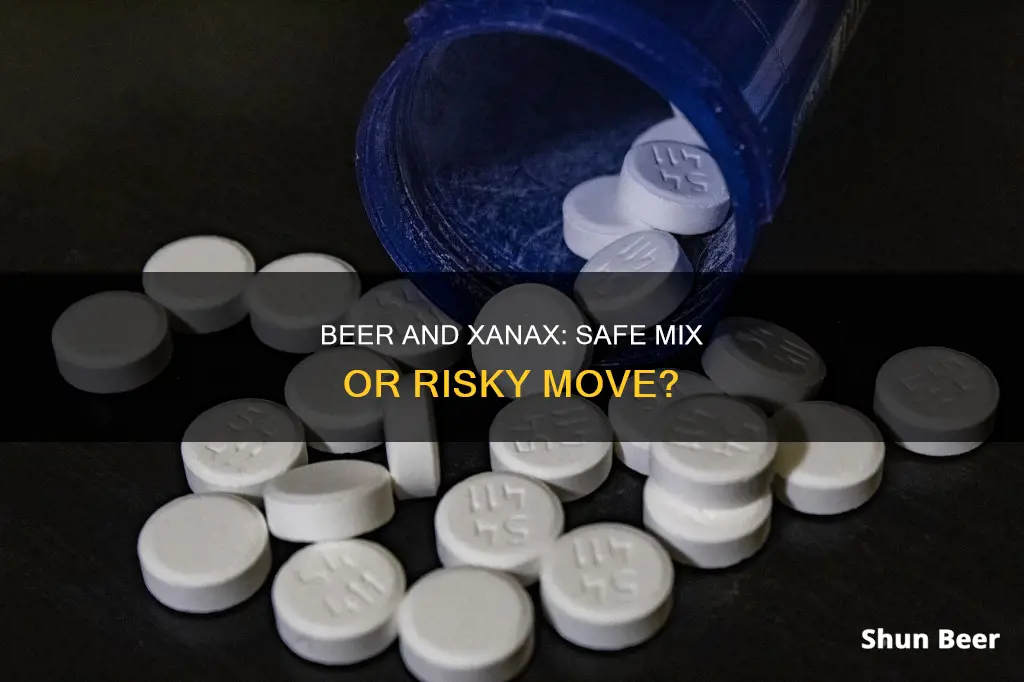
Mixing Xanax and alcohol is extremely dangerous and can even be fatal. Both substances are central nervous system depressants, which means they slow down nervous system activity. When taken together, they exaggerate each other's effects, leading to a range of physical and mental side effects. These include extreme sleepiness, poor coordination, slowed reflexes, slowed heart rate, impaired memory and cognitive function, and respiratory depression. The combination also increases the risk of overdose, addiction, and long-term physical and mental health problems.
| Characteristics | Values |
|---|---|
| Effect on the body | Slows down nervous system activity |
| Effect on the brain | Increases activity of the inhibitory neurotransmitter gamma-aminobutyric acid (GABA) |
| Effect on the liver | Can lead to liver damage or failure |
| Effect on the heart | Can lead to cardiac arrest |
| Effect on breathing | Can lead to respiratory depression or failure |
| Effect on memory | Can lead to memory loss |
| Effect on mental health | Can lead to increased feelings of relaxation, detachment, and decreased feelings of panic and anxiety |
| Risk of overdose | High |
| Risk of fatality | High |
What You'll Learn

Increased Sedative Effect
When taken together, Xanax and alcohol can have a dangerous increased sedative effect on the body. Both substances are central nervous system depressants, which means they slow down nervous system activity. They also both increase the activity of the inhibitory neurotransmitter gamma-aminobutyric acid (GABA) in the brain, which causes a sedative effect. When depressants are mixed, over-sedation can occur, leading to respiratory depression, cardiac arrest, and loss of consciousness.
The sedative effects of Xanax and alcohol are intensified when the two are taken together. This can lead to heightened effects of anxiety reduction, sedation, lethargy, decreased motor reflexes, and more. The increased sedative effect can also cause individuals to become unconscious or even comatose.
The liver also needs to work harder when breaking down both alcohol and Xanax in the body. This can result in a dangerous buildup of Xanax in the system, as the liver prioritizes metabolizing alcohol.
Due to the increased sedative effect, individuals may also experience memory issues when mixing Xanax and alcohol. This can lead to blackouts, where one cannot remember what happened while under the influence of the substances.
The increased sedative effect of Xanax and alcohol can be extremely dangerous and even fatal. It is important to seek help if you or someone you know is struggling with this combination.
Wet Paper Towel on Beer: Does This Method Work?
You may want to see also

Impaired Memory and Cognitive Function
Mixing alcohol and Xanax can have serious consequences for your memory and cognitive function. Both substances are central nervous system (CNS) depressants, which slow down brain activity. They also have similar mechanisms of action: Xanax acts on GABA-A receptors, while alcohol acts on GABA-A and NMDA receptors. This means that taking them together leads to synergistic effects, with the impact of both substances being greater than the sum of their parts.
The combination of the two can result in an enhanced high or "buzz", as well as intensified side effects. These can include:
- Fatigue
- Drowsiness
- Impairment
- Loss of coordination
- Loss of muscle control
- Slurred speech
- Difficulty walking
- Changes in behaviour
- Memory loss
- Impaired concentration and attention span
- Permanent brain damage
- Alcohol-related dementia
- Cognitive impairments
In addition, the liver has to work harder when breaking down both alcohol and Xanax, and the combination increases the risk of a fatal overdose.
Old Beer: Is It Safe to Drink After Years?
You may want to see also

Respiratory Depression
Xanax and alcohol increase the activity of the inhibitory neurotransmitter gamma-aminobutyric acid (GABA) in the brain. This chemical causes a sedative effect, and when mixed, the effects of both substances are intensified. This can lead to slowed or difficult breathing, loss of motor control, and changes in behavior. The combination of Xanax and alcohol also increases the risk of a fatal overdose, with respiratory depression being a common symptom.
The liver needs to work harder when breaking down both alcohol and Xanax, and the presence of ethanol in alcoholic drinks can increase the maximum concentration of alprazolam (the active ingredient in Xanax) in the bloodstream. This can cause an enhanced high or "buzz", as well as enhanced side effects, including respiratory depression.
It is important to note that even one or two drinks can be unsafe if you are taking Xanax. It is recommended to wait at least five days after stopping Xanax before consuming alcohol. The combination of these substances can have serious and life-threatening consequences and should be avoided.
Heart Stents and Beer: Is It Safe?
You may want to see also

Increased Risk of Overdose
Mixing Xanax and alcohol can lead to an increased risk of overdose. Both substances are central nervous system depressants, which slow down your nervous system and increase the activity of the inhibitory neurotransmitter gamma-aminobutyric acid (GABA). When combined, they can cause over-sedation, leading to respiratory depression, cardiac arrest, and loss of consciousness.
The risk of overdose is heightened as both substances are broken down by the liver, which can become overwhelmed, leading to a dangerous buildup of Xanax in the system. This can result in a fatty liver, which can progress to cirrhosis, a potentially fatal condition requiring a liver transplant.
Additionally, the effects of Xanax and alcohol are unpredictable and can vary from person to person. There is no safe amount of alcohol that can be consumed with Xanax. Even a small amount of alcohol can lead to a dangerous reaction when combined with Xanax.
Heart Surgery and Beer: What's Safe to Drink?
You may want to see also

Addiction and Dependence
Mixing Xanax and alcohol is dangerous and can lead to addiction and dependence. Both substances are central nervous system depressants that slow down brain activity and have similar mechanisms of action. When taken together, the effects of both substances are intensified, leading to unpredictable and adverse effects.
Xanax is a prescription drug used to treat anxiety and panic disorders. It is a benzodiazepine, which is a type of sedative hypnotic. Alcohol is a legal substance that people use to relax and socialise. Both substances have similar properties, and when mixed, they can lead to dangerous consequences.
Taking Xanax with alcohol can cause a range of adverse effects, including slowed or difficult breathing, loss of motor control, and changes in behaviour. It can also lead to an increased risk of accidents and injuries, especially if driving under the influence. Additionally, mixing Xanax and alcohol can result in a life-threatening overdose.
Long-term use of Xanax and alcohol is associated with the development of physical and psychological dependence. The body gets used to the presence of these substances and needs them to function without experiencing withdrawal symptoms. Withdrawal symptoms can include anxiety, irritability, and seizures.
Xanax and alcohol can also affect a person's mental health. Both substances can worsen mental health conditions, such as depression, and increase the risk of experiencing a mental health disorder.
To treat addiction and dependence on Xanax and alcohol, it is crucial to seek professional help. Treatment typically begins with medical detox, followed by therapy to address the underlying reasons for addiction and to develop healthy coping mechanisms. It is important to be patient throughout the treatment process and to seek ongoing support to ensure a long-term, complete recovery.
Lip Fillers and Beer: What's Safe to Drink?
You may want to see also
Frequently asked questions
No, it is not safe to take Xanax after drinking a beer. Both substances are depressants, which means they slow down your central nervous system. When taken together, they can cause respiratory depression, cardiac arrest, and loss of consciousness.
The side effects of mixing Xanax and alcohol include increased sedation, impaired memory and cognitive function, respiratory depression, and an increased risk of overdose.
There is no safe amount of alcohol to drink with Xanax. The effects of mixing the two substances can vary from person to person, and even small amounts can lead to a dangerous situation.
The long-term effects of mixing Xanax and alcohol can include severe liver issues, ranging from a fatty liver to cirrhosis of the liver, which can be fatal. Mixing the two substances can also increase the risk of addiction and dependence.
If you or someone you know is struggling with Xanax and alcohol abuse, there are many resources available for help, including addiction treatment centres, support groups, and healthcare providers. It is important to seek professional help as soon as possible to reduce the risk of irreversible damage.







